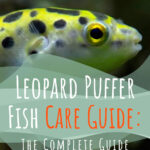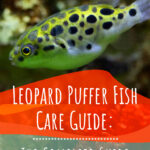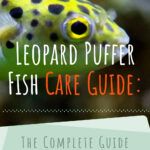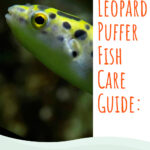Puffer fish are characterful creatures that are sure to capture your heart, and the Leopard puffer is a particularly attractive variety.
In this guide, we take a closer look at the delightful Leopard puffer so that you know what you’re taking on if you choose to bring one of these cuties home from the fish store. Are Leopard puffers suitable for a community tank? Are these fish easy to care for and suitable for a beginner? What do you feed a Leopard puffer?
Read on to find out all you need to know about these fascinating fishes!
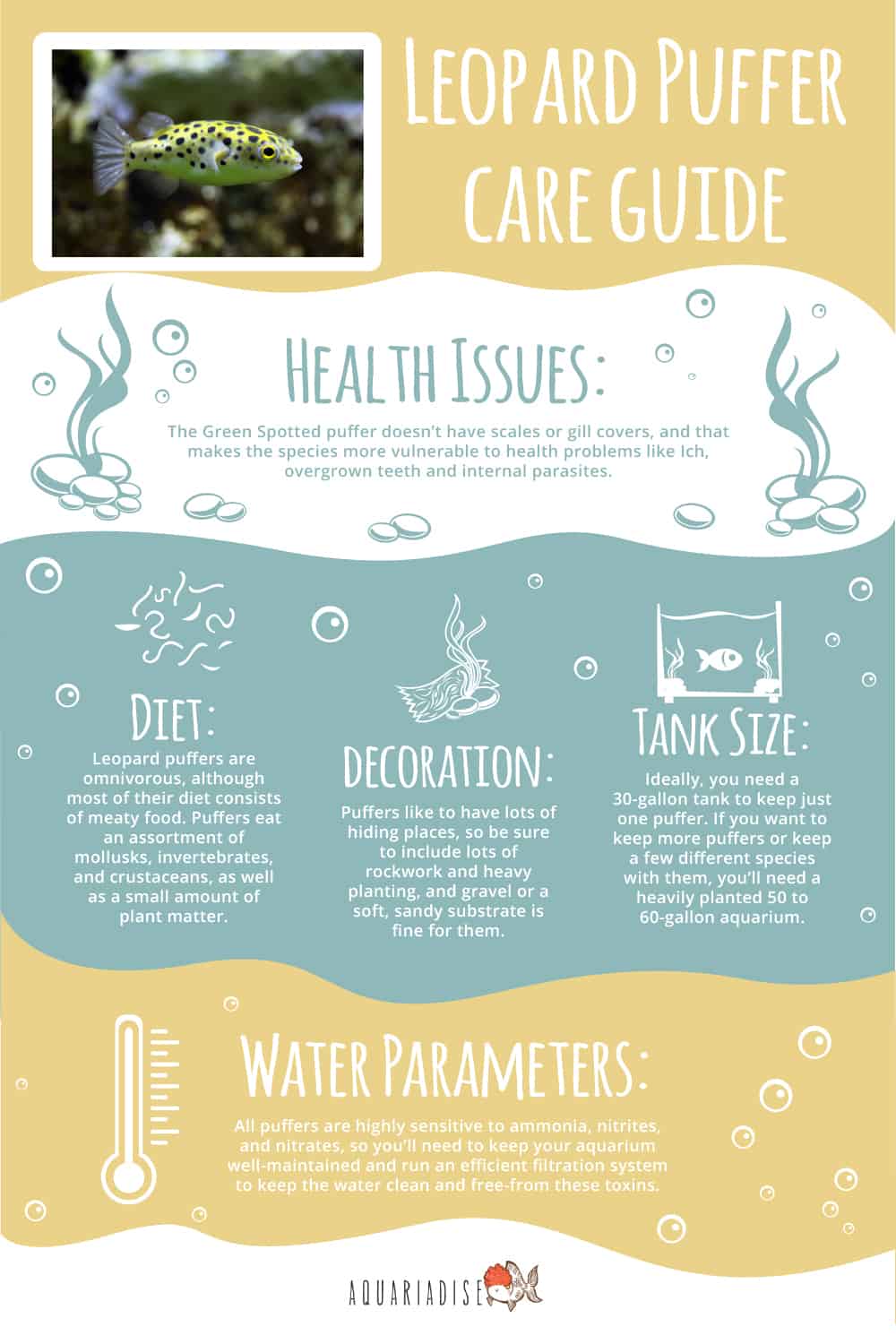
Leopard puffer – Overview
The Leopard puffer belongs to the Tetraodon order of freshwater fishes, is also known as the Green Spotted puffer, Spotted Green pufferfish, Green Spotted pufferfish, and Burmese puffer, and has the scientific name, Dichotomyctere nigroviridis.
Leopard puffers are tropical brackish water fishes that live for up to 15 years, growing to measure six inches long. The fish that you see in fish stores are usually wild-caught in their natural habitat in South and Southeast Asia.
Puffers are undoubtedly the cutest fish around! They have bulbous, enquiring eyes that seem to constantly follow you, hoping for food, and their wobbling swimming style and round bodies are enchanting. However, don’t be fooled! Puffers have teeth that they use to munch on snails, smaller fish, and invertebrates, making them unsuitable for many community setups.
Availability
Leopard puffers are commonly available from fish stores and online dealers. The species is moderately priced at around $10 to $15 dollars, depending on the specimen’s age, size, and coloration.
Origins and habitat
These lovely fishes are found ranging right across Africa through to Asia from Sri Lanka to Indonesia and further north as far as China and were first described in 1822 by Marion de Procé.
Leopard puffers inhabit brackish to freshwater streams, flood plains, rivers, and coastal estuaries, where they feed on crustaceans, mollusks, and other small invertebrates. Puffers are also known to eat the fins and scales of other fishes, which makes them unsuitable for life in a community tank. The puffer’s habitat has plenty of aquatic vegetation, rocks, and a sandy or fine pebbly substrate.
Although many fish stores market Spotted puffer fish as freshwater fishes, the fishes’ habitat is primarily brackish. That being said, puffers do migrate into flooded, freshwater areas during the rainy season as juveniles. Before they become fully mature, young puffer fish are able to tolerate swimming through freshwater, saltwater, and brackish conditions.
Appearance
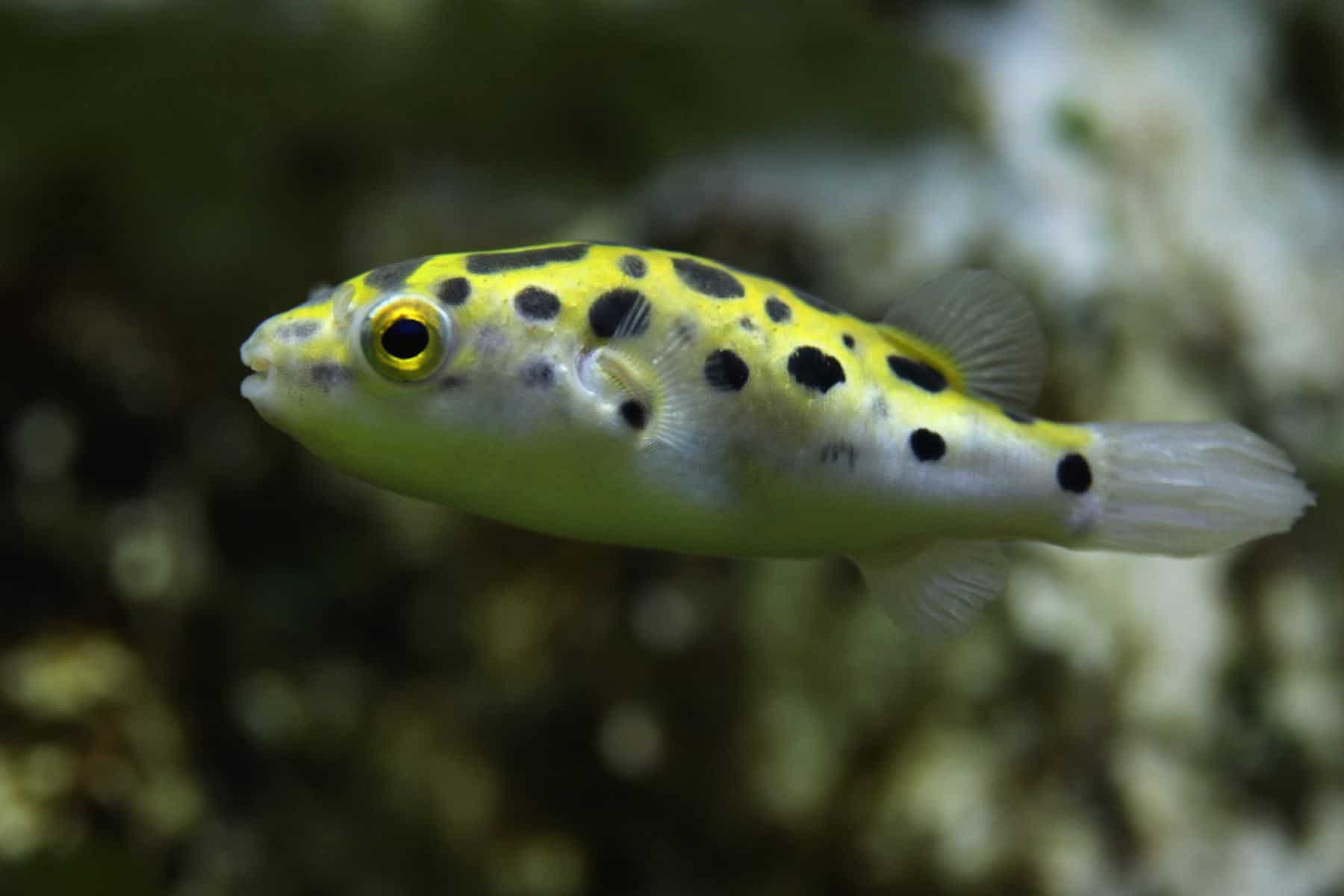
The Green Spotted puffer fish has a rotund, stout body with little spines. These cute fishes’ main appeal is their round, comical face with its tiny mouth, bulging eyes, and broad forehead.
The fish’s color varies between individuals, but they all have bodies that shade from a rich green upper body covered with dark spots to a creamy whitish underside. In juvenile Leopard puffers, the green coloration is not as colorful as in adults.
The fish have a natural defense mechanism where they “puff” up their bodies with water or air if they feel threatened. When inflated, the puffer’s spines stick out, preventing the fish from being eaten by predators. Some species of puffer produce toxins when alarmed, rendering their flesh poisonous if eaten.
At full maturity, the Green Spotted puffer fish grows to around 6.7 inches in length. Spotted puffers live for up to 15 years when kept in ideal conditions in a marine or brackish tank.
Are Leopard puffers easy to keep?
The Green Spotted puffer is not a suitable aquarium fish for a beginner, as puffer care requirements are not straightforward.
As juveniles, puffer fish are happy to live in freshwater. However, as the fish reach adulthood, they need brackish or marine water. That means more work and experience is required on the part of the hobbyist to maintain a suitable environment for the puffer. So, the pufferfish is most suited to a fishkeeper with experience in keeping marine fish.
These fish need much more space than most community tropical fish species, requiring 30 gallons of water per puffer. Puffers are messy eaters, too, so you’ll need to carry out more frequent water changes than you would usually do.
Puffers are scaleless fish, which makes them more vulnerable to parasites and diseases. These fish have a set of teeth that grow very quickly. Those teeth need to be physically clipped from time to time to prevent the teeth from becoming overgrown.
So, if you’re an experienced aquarist with a marine tank and you fancy taking on a challenging pet, a Leopard puffer could be the right fish for you!
Diet and nutrition
Leopard puffers are omnivorous, although most of their diet consists of meaty food. In nature, puffers eat an assortment of mollusks, invertebrates, and crustaceans, as well as a small amount of plant matter.
In captivity, you can feed your puffer a selection of tropical flake, live, and frozen foods, including bloodworms, shrimp, crabs, snails, and brine shrimp. Adults enjoy shelled-shrimp, clams, whole mussels, scallops, crayfish, oysters, and crab legs. Hard-shelled foods are an important addition to the puffer’s diet, as they help to wear down the fish’s teeth. Note that if the puffer’s teeth become overgrown, it will be unable to eat, and you will need to manually clip the teeth.
Overfeeding is a common problem with puffers. These fish are natural hunters, burning off calories chasing their prey. In captivity, the fish don’t have that degree of exercise and quickly become overweight and unhealthy if you feed them too much. We suggest that you feed your puffers only small amounts of food two or three times a day.
Aquarium setup for Leopard puffer fish
As with all fish species, you want to replicate their natural habitat and water conditions as closely as possible to keep the fish happy.
Tank size
Ideally, you need a 30-gallon tank to keep just one puffer. If you want to keep more puffers or keep a few different species with them, you’ll need a heavily planted 50 to 60-gallon aquarium.
Despite their ungainly appearance, puffer fish are surprisingly accomplished jumpers, so you’ll need to provide a tank with a very well-fitting lid or a cover slide. Juvenile puffers habitually jump from puddle to puddle during the rainy season in their natural environment, searching for food and returning to their river home.
Decoration
Puffers like to have lots of hiding places, so be sure to include lots of rockwork and heavy planting, and gravel or a soft, sandy substrate is fine for them.
These fish like to swim in the middle to bottom of the water column, so leave plenty of open water swimming space for them.
Water parameters
Leopard puffer fish are tricky to maintain because their requirements change as they mature. Juveniles can tolerate freshwater, but they need a brackish to marine environment as they mature.
Juvenile Spotted puffers need salinity levels of between 1.005 and 1.008, whereas adult fish need a water salinity of 1.018 to 1.022 to keep them healthy and thriving. Use a marine salt formula and monitor salinity with a hydrometer.
All puffers are highly sensitive to ammonia, nitrites, and nitrates, so you’ll need to keep your aquarium well-maintained and run an efficient filtration system to keep the water clean and free-from these toxins. The pH should be on the alkaline side at between 7.5 and 8.5, so add aragonite or crushed coral to your substrate to maintain that or use a chemical pH balancing formula. Water hardness should be between 9 and 19 dGH. Puffers are tropical fish, needing a water temperature of 74° Fahrenheit to 82° Fahrenheit.
Filtration in a puffer tank needs to be highly efficient, as these fish produce a fair amount of waste and are very messy eaters. We recommend using large canister filters that turn the water over six to ten times every hour. You’ll also need to use powerheads to mimic the river current in the puffer’s natural habitat.
Because they’re such mucky creatures, a 35% to 50% water change is recommended as standard.
How to introduce puffers to your tank
Leopard puffers are extremely sensitive to changes in water conditions and need to be introduced to an established tank.
Regardless of the age of the puffer you buy, you must introduce it slowly to its new tank, typically using the drip method. If the puffer starts off in freshwater, move the fish to a brackish tank before introducing it to a marine tank.
Tankmates
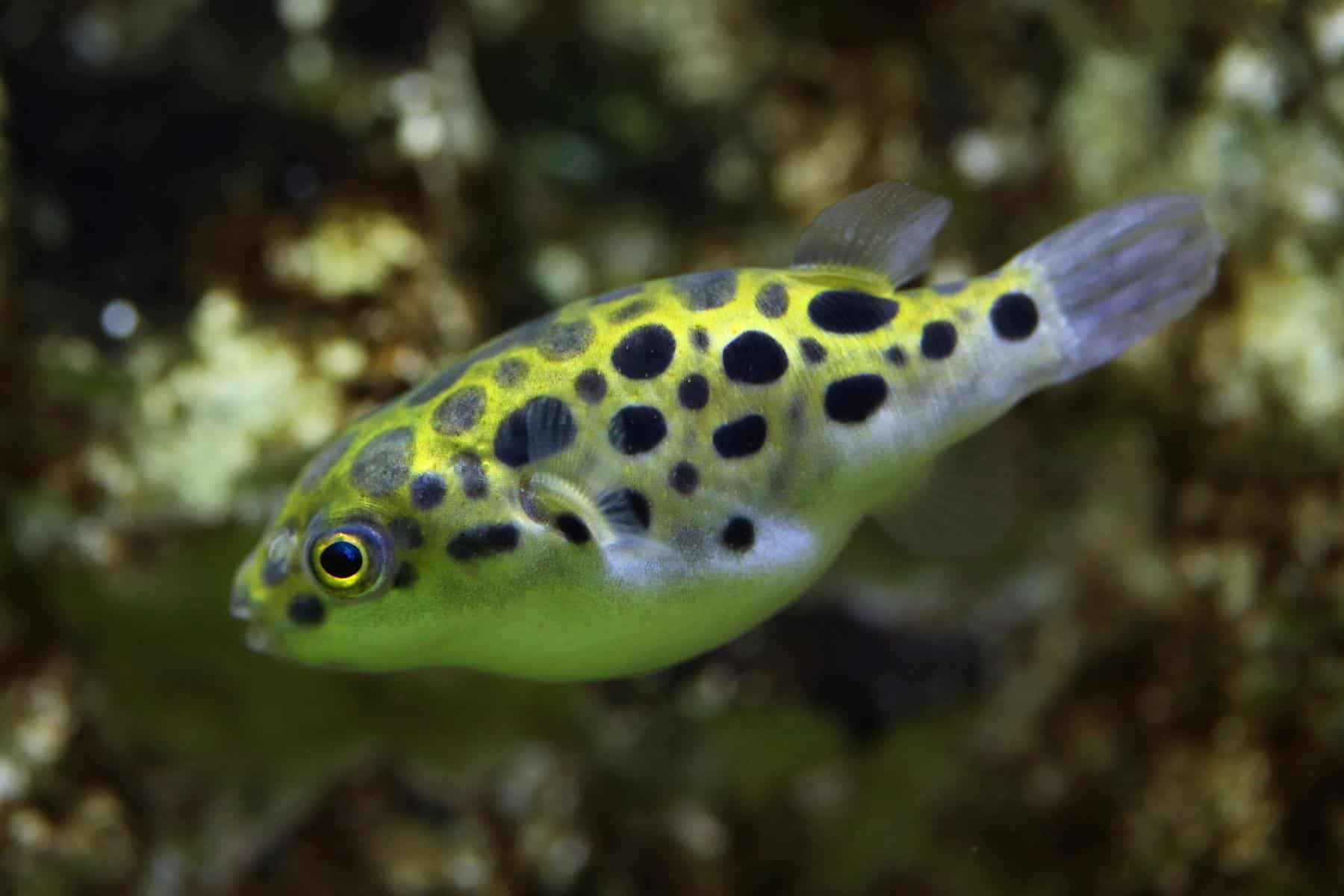
Puffers are very territorial, and they do need plenty of space to themselves. If you do have more than one specimen, it’s recommended that you use plenty of dense planting, caves, and other decorations to disrupt the puffers’ line of sight and create clear territorial boundary lines.
These fish vary in temperament and personality between individuals. However, they are all regarded as aggressive and will nip the fins and scales of other fish. Shrimp, snails, and crabs are all regarded as a food source and will be eaten by the puffer, so, unfortunately, don’t make suitable tankmates.
You can keep Leopard puffers in a community setting with others of the same species or with large, non-aggressive fish. Make sure that there’s plenty of room in the tank, incorporate lots of lush planting, and provide rocks, roots, and other decorations to create clear territorial boundaries and provide a hiding place.
Breeding and reproduction
The examples of Tetraodon nigroviridis that you see for sale online and in fish stores are wild-caught, as these fish are not bred commercially. However, a few experienced hobbyists have successfully raised Spotted puffers. Female fish lay around 200 eggs on a sheltered surface. It’s thought that the nest is then guarded by both fish, with the male taking the lead role in protecting the eggs until they hatch after about a week.
Unfortunately, puffer fish fry’s mortality rate is very high, but if some survive, you should offer them baby brine shrimp and microworms. As the fry get larger, they will begin eating small snails.
Health and disease
The Green Spotted puffer doesn’t have scales or gill covers, and that makes the species more vulnerable to diseases and attack by parasites.
Ich
White Spot Disease or Ich is a common disease of freshwater and marine fish. As they don’t have scales to protect them, Tetraodon nigroviridis is often the first fish in your tank to show signs of Ich. The protozoan parasite Ichthyophthirius multifiliis causes Ich. Although the parasite is present in many tanks, it only attacks old, weakened diseases, or poor water conditions.
Fish with Ich rub or flick against things in the tank as they try to shift the parasites from their skin. A rash of tiny white spots develops on the fish’s gills, fins, and body. If left untreated, the parasites can clog the gills, preventing the fish from breathing and potentially causing suffocation.
You can treat Ich by elevating the tank temperature to 86° Fahrenheit for three days. Simultaneously, treat the water with an Ich medication that you can buy from fish stores and carefully follow the manufacturer’s instructions.
Overgrown teeth
A very common health problem for puffers is that their teeth become overgrown. You can help by feeding your puffers shelled foods such as snails, but you will need to trim their teeth from time to time.
To trim your pet’s teeth, place the puffer in a small container of tank water. Add three drops of clove oil per liter of water to sedate the fish so that you can hold it more easily. Use cuticle clippers to nip off excess growth on the fish’s bottom and upper teeth. When you’ve finished, put the puffer in a net or container and allow the current to flow over it until the puffer revives.
Internal parasites
The Green Spotted puffer that you buy in your local fish store is pretty much guaranteed to be wild-caught. That means there’s a good chance that your new purchase will be carrying some form of internal parasite.
If the fish store hasn’t already done it, you’ll need to use a de-worming medication before adding your new puffer to your main display tank.
In summary
The Leopard puffer or Green Spotted puffer is a characterful fish that many beginners are beguiled by when they see the fish’s cute little face peering at them from a display tank in a fish store.
However, don’t let those sweet, innocent looks fool you! Puffers are aggressive creatures that nip fins and eat the scales of other fish in their tank, not to mention gobbling up any invertebrates that happen to be within reach. Also, although juvenile puffers can survive quite happily in freshwater, adults must live in brackish water or a marine environment to thrive.
If you’re an experienced aquarist with the time to devote to caring for the Green Spotted puffer, one of these fascinating little fishes might make the perfect addition to your collection of fishy friends.



